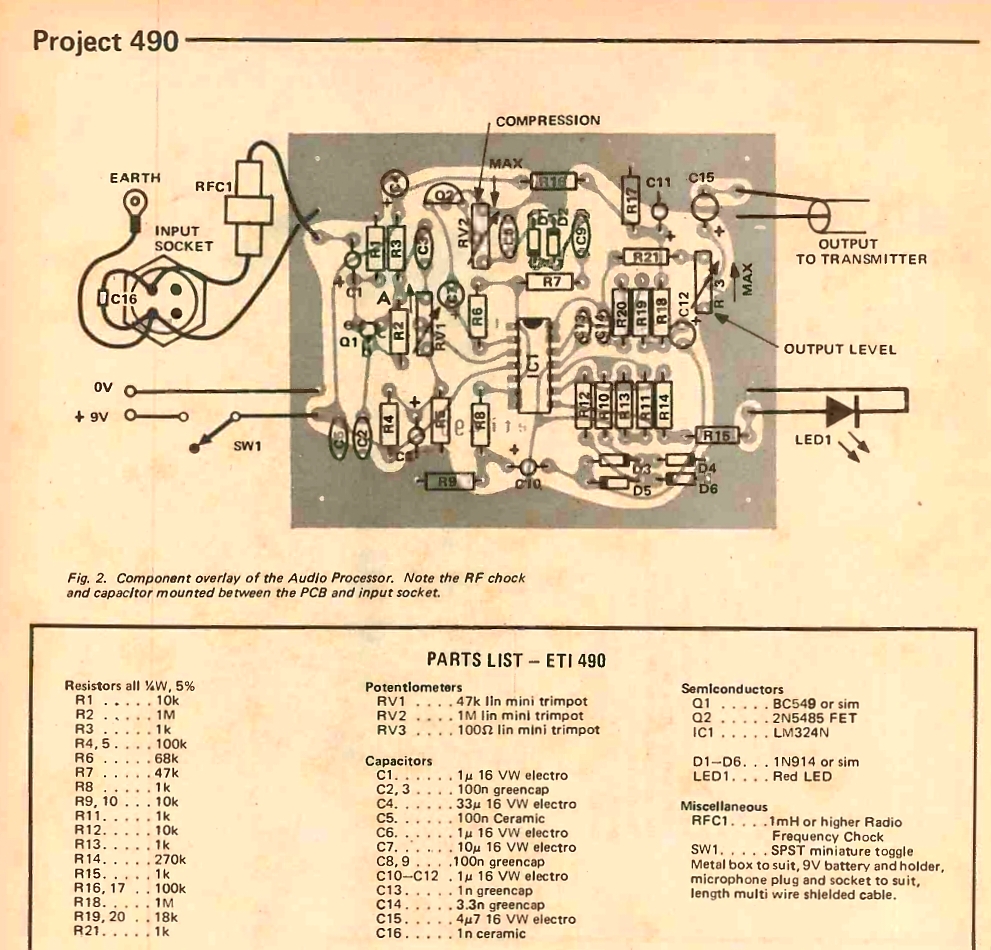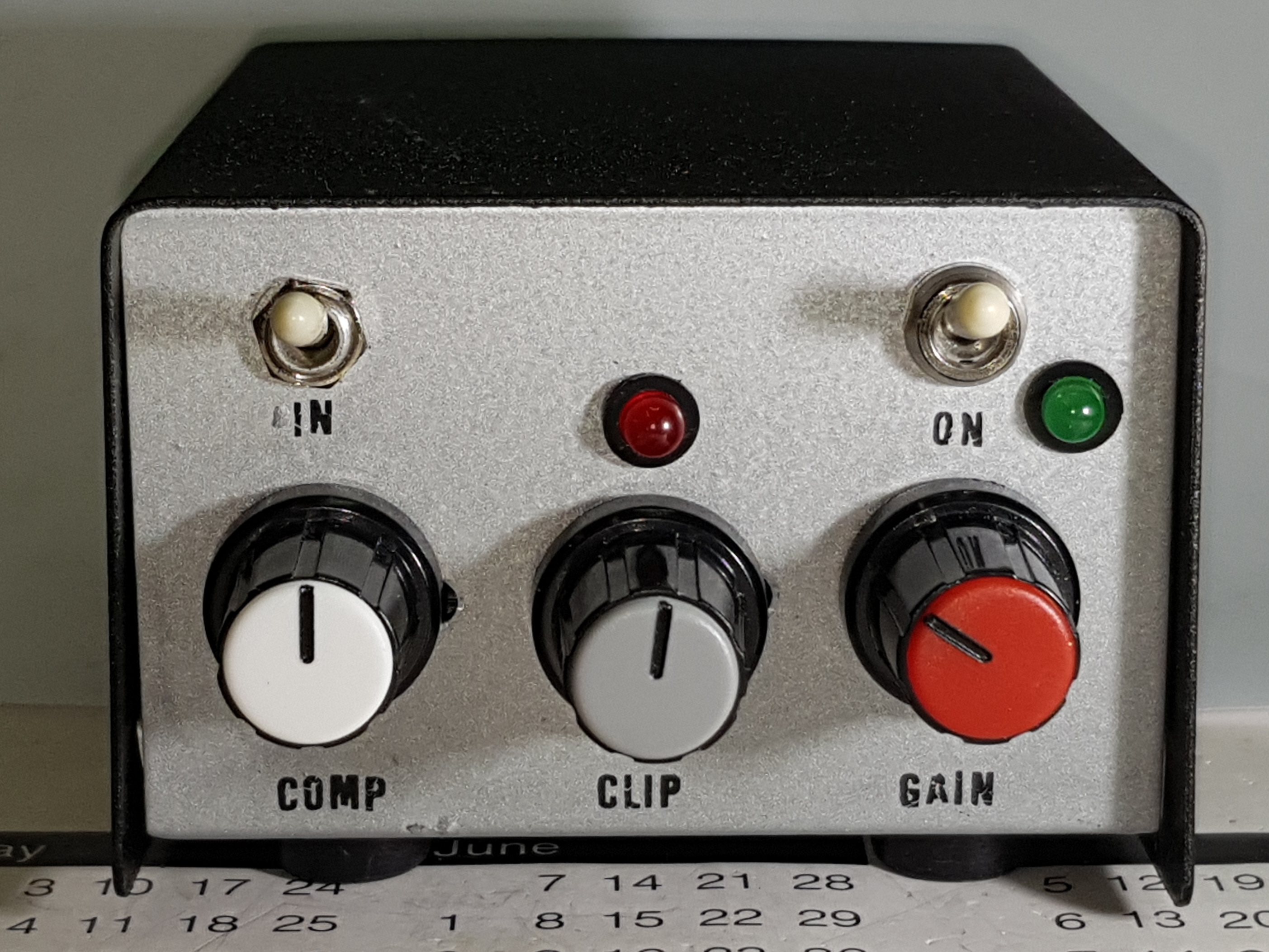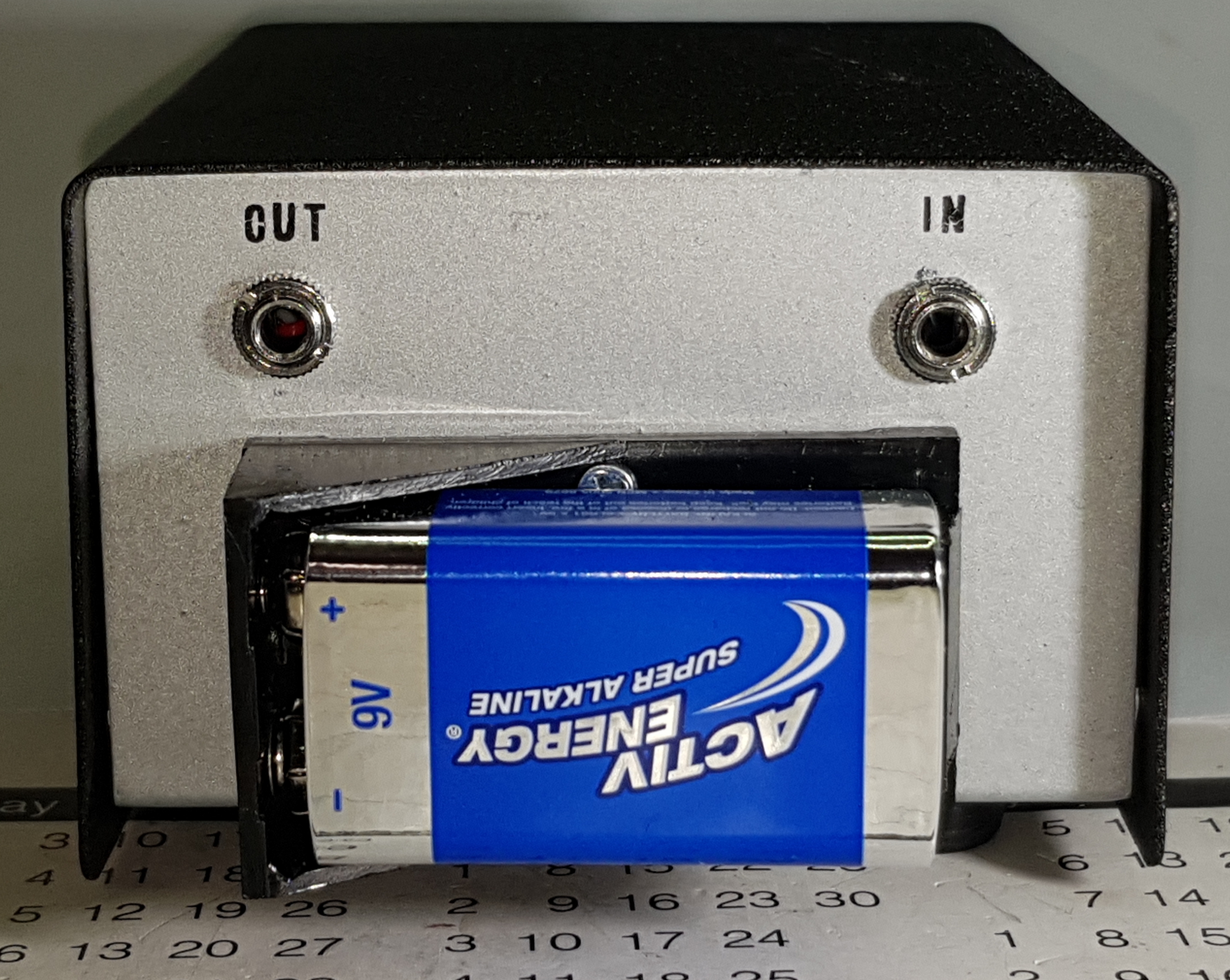
Whilst sorting electronics junk recently I unearthed this board. My build of the Electronics Today International microphone compressor, ETI490, published in the magazine in December 1978. I remember preserving my copy of this magazine for many years, long after the pages faded and cover tattered, as it contained the construction article for this useful amateur radio station component.

Condition and styling
The board was in fairly good condition and almost complete. A couple of things struck me. One was how big the thing was. An entire transceiver would easily fit in this area today. Six or 8 ESP32 MCUs with Tensilica Xtensa LX6 microprocessor @240 MHz with 520 KB SRAM and enough features to fill the rest of this blog post could fit in this space today.
It wasn’t only the board area that stood out, but the acres of distance between individual components. So much space. Wasted space by today’s standards. Clearly, electronics had not progressed far along it’s incredible shrinking act, leading to smaller and smaller leaded components, then the first generation of surface mount parts, to today, where you can’t even see the parts without a microscope. Product size and PCB space in 1978 were without cost and not considered a negative. In fact, in so much as it made components like this serviceable, space and a wide open layout was an asset.
Another striking thing was the age of some of the carbon resistors I’d used. Resistors that looked like they’d been cut from old valve television chassis. And they probably were. That’s what I used to do in my teenage years — and I still do it today — pick up other people’s electronic junk and strip it.
Reminiscing
Seeing this talisman from my youth brought memories flooding back from 1978, my final year of school. With Citizens Band radio at its frenzied height and C. W. McCall’s ‘Convoy’ playin’ on the AM radio hourly, speech compressors or so-called ‘Power Mikes’ were all the rage.

Most of these were run flat chat and blasted the Good Buddy’s breathing noises S9+40dB across tens of kHz of the 27MHz spectrum. They appeared with CBs and 5/8th wave antennas every Thursday in our second hand trash’n’treasure paper, The Melbourne Trading Post, with effusive claims, such as ‘no need for a linear’ or ‘be the loudest voice on the channel’ or ‘ worked the USA three times’. A PowerMike and a 1:1 SWR were the keys to the world .
My use of a speech compressor was much more demure. At the time I was running a homebrew sideband transmitter on 80 meters called the Tucker Tin II by Fred ZL2AMJ. I say sideband and not SSB because although it was a phasing type rig, it produced almost as much upper sideband as it did lower.
Phasing was my only option in 1978. We couldn’t source nor afford crystal filters in those days, and the tsunami of cheap computer crystals was about 5 years hence. My Tucker Tin managed to somehow get an odd mix of both sidebands at 3.6MHz onto the grid of a single 12BY7, for 3 to 4 watts output. Needless to say, on a quiet band in the days before switch mode power supplies and solar inverters, and into a dipole, it worked quite well, and I made contacts all over Australia and New Zealand.
The ETI490 speech compressor gave it some much needed punch in noisy conditions. As I examined the old board, I noticed that the three trimpots, for clipping, compression and output level, were all set full on or close. I was young back then! 😉
Article
I’d long ago lost my copy of ETI so turned to the interweb for help. Google delivered. There it was, a good quality scan of the magazine from 40 years ago. It’s worth browsing old electronics magazines to remind yourself just how far we’ve come.



We forget that the options to procure electronic components in 1978 were not what they are today. No e-commerce, eBay or Ali-express. Very limited weekend trading. Back then, I’d often find myself short of a red LED, a BC549 or a 33uF electrolytic on a Sunday, and pull them from my own projects. That’s exactly what I’d done to my compressor at some point. So first, I had to replace these parts.
Powering and Boxing
Once done, the board powered up with an electret mic and the digital scope on the output, and it worked first time. Obvious compression, and amplitude limiting was visible on the scope.
At this point I decided that the combination of sentimentality and the utility of a working mic compressor was more than enough motivation to box it up and keep it working. I remembered a nice little project box I had kept for a rainy day, and found that the ETI490 could be made to fit if I sawed about 3mm off each end. No traces were lost by doing this, such was the unused acreage of the original PCB.


The rest of the fit out was straightforward. I used an external 9v transistor battery holder, mounted on the rear panel for convenience. So often, internally mounted batteries go flat, die, then leak, damaging the electronics inside. Out of sight is out of mind, and with batteries, that’s not necessarily a good thing.
Performance
Here’s two scope waveforms with an electret microphone straight through, and clipped/compressed.


Onward
I first made this project in 1978 as a teenager and remade it in 2019. That’s 41 years. I sure hope I’ll be around in another 41 years to make it a third time. The year will be 2060. I’ll be 100 years young. Now that’s something to look forward to.


Great stuff Paul. I wish I could find some of my creations from the 1970s! FB on building it a THIRD time. Go for it OM! 73 Bill
LikeLike
Thanks Bill, and special thanks for commenting. When I rebuild it for a THIRD time, I’ll teleport over and show you 😉 73 Old Man, Paul VK3HN.
LikeLike
Just chanced on this post, Paul, and your points about space on boards are so true. I have an unbuilt compressor kit – but I think from the 90s, “much more recent”, and I think it has a roger beep option. Now it has been replaced by the chips with noise gates etc but I will eventually find time to build it. I will try to let you hear it once I’ve done that! 73 Andrew VK1DA/VK2UH
LikeLike
Thanks for commenting Andrew. When you look at boards from the 90s and 80s it makes you realise how much smaller electronics has become. I played with a compressor /gate using the SSM2167 recently, it is the size of a thumbnail. Mind you I blew it up but thats another story.
Down at the bottom of my blog there’s a subscribe button. That way you won’t have to ‘chance’ on any future posts!
73 Paul VK3HN.
LikeLiked by 1 person
Actually I subscribed some time ago, but I’ve not been diligent about following up the notifications about new posts. I find all your posts are informative and even entertaining. Thanks, Andrew.
LikeLike
Cheers Andrew!
LikeLike
The SSM2167 is an updated version of the earlier SSM2165, which is used in the German FT*17 compressor. I notice there are boards for sale with the 2167 on them, fairly affordable too. Project N+1. 🙂
LikeLike
$3.59 with free posrage. No excuses 😉
https://www.ebay.com/itm/SSM2167-Microphone-Preamplifier-Board-Low-Noise-COMP-Compression-Module-DC-3V-5V/222981780267?_trkparms=aid%3D555018%26algo%3DPL.SIM%26ao%3D1%26asc%3D20190717082801%26meid%3De4cb1db90832437abf2b6c004288a28e%26pid%3D100889%26rk%3D1%26rkt%3D12%26sd%3D263363354220%26itm%3D222981780267%26pg%3D2349624&_trksid=p2349624.c100889.m5204
LikeLiked by 1 person
Correct, I saw some PCBs on Aliexpress, almost a complete compressor other than mike connectors. The German design has a compression level control and the other pot is to adjust the gain of the preamp, which also affects compression. But there is no output level control, which I think is a limitation of that design. How can you adjust it so that the levels are correct (peak uncompressed level = peak compressed level) without an output control.
LikeLike
You can’t. But it would be easy to add one.
LikeLike
I have reworked this old pcb with Sprint Layout and it is much smaller now, say 5×5 cm, which is not big at all.
LikeLiked by 2 people
Good day, I have been searching the web for a suitable proven speech processsor to add to my TS-50 similar to the one I built in the mid 80’s and I cant recall the magazine I sourced it from. The one article I found in a 1974 Practical Wireless mag on pg 36 appears to be identical to the one I built in the 80’s: https://www.americanradiohistory.com/UK/Practical/Wireless/80s/PW-1986-03.pdf
HA6VSR Is it possible to provide me with a copy of your reworked pcb layout please? And I’d like to say thanks to VK3HN for unknowingly coming to my “rescue” with this post.
LikeLike
Hi, thanks for your comments. The PW processor from 1980s is an RF speech processor, a more complex design than the ETI unit which is an audio compressor. The PW processor modulates audio onto a 455khz carrier and clips it at RF before demodulating it back down to audio.
I don’t have the PCB artwork for the ETI compressor, is it in the article? Ill have a look. Do you want to build the PW processor or the ETI compressor?
LikeLike
Hi Paul
Thanks for getting back to me so promptly. Yes the RF processor is a more complex build than the ETI hence my interest in it so yes I would prefer to build the ETI. The circuit is visible in the article but not downloadable . If you are able to provide a downloadable copy I would appreciate it thanks. BTW between the 2 which in your opinion is a better processor and why?
LikeLike
Great project, Paul! I still have dozens of those OPs LM324 here in the junk box. I think, I should give this circuit a trial! Vy 73 de Peter (DK7IH)
LikeLike
Thanks Peter. In 2020, I would recommend the SSM2167 from Analog Devices, a much better compressor, and it includes a noise gate and limiter. It is only 10 years old, not 40!
LikeLike
Nice project rebuild. I used a compressor board salvaged from an old power mic. I adapted it to work with a UNIDEN 2020 HF rig I have. I have the articals of the Tucker Tin Mk 2, but never built it!
LikeLike
Thanks Darryl. The technology from this era (1980s) is easily worked and adapted and of course still works well enough.
LikeLike
Great little compressor, I build it for my Yaesu FT-101E. Very interesting blog. Many thanks from Argemtina.
LikeLike
Hi Lucas. That would be a good combination, a ‘PowerMike’ into an FT101E. Didn’t the 101E have an RF speech processor? If you didn’t set it up properly you could really splatter with that !
LikeLike
[…] MICROPHONE COMPRESSOR FROM 1978 LIVES AGAIN (ETI490) […]
LikeLike
Hello Paul, Nice work here. I have been trying the SSM2167 and had issues on 2 PCB builds now and just cant get it to work well. In despair I am starting again with this/your design. I hope this is ok?
The issue with the SSM2167 is to do with RF feedback, and the SSM2167 is very susceptible to it. It is not radiated but getting into the mic input etc when over 10W ( and the design is for 100W!). It produces another signal at half of the audio signal generator input. Example 3khz tone in and it produces a 1.5khz signal that increases over the 3k tonne. I have spent weeks on this now! I have concluded rightly or not that as the SSM2167 has a very low power supply voltage it doesn’t take very much RF to get in anywhere for it it get upset.
I I’m starting a wee test board from your design here with modern parts and SMD and will see how that goes. The LM2904 I’m planning to use can be powered from 12V etc…
Any thoughts or suggestions or a chat would be nice. My project website below…
Thanks…, Michael ZL3AX (J87AB / G0GPX)
LikeLike
Hi Michael,
Thanks for commenting. I also played around with SSM2167 microphone compressors. I had limited success also. One attempt was to build a compressor for my 150 watt AM transmitters. It was properly shielded in a diecast box. I just couldn’t get it correctly adjusted. The audio sounded horrible at almost all settings.
The old ETA compressor worked OK, it was prone to overdriving and severe clipping so you had to use it sparingly, but it certainly compressed and boosted ‘talk power’.
In the end, I got a decent condenser microphone (Rode NT1) and a balanced mic preamp, and the high output and sensitivity of the large format microphone satisfied my desire for plenty of audio on my AM transmissions. Plus it looked the part!
Good luck with your compressor project and check back in to let me know how it goes.
73 Paul VK3HN.
LikeLike